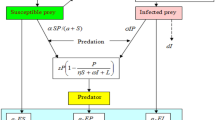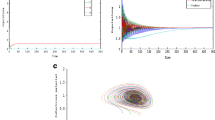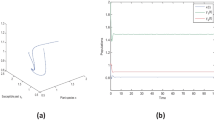Abstract
This paper describes the dynamics of an infectious disease transmission modified Leslie–Gower type eco-epidemiological system in both deterministic and stochastic fluctuating environments with harvesting. The dynamics of the deterministic system is extensively investigated around coexistence equilibria. Sufficient conditions are derived for local and global stability of the system. The existence of Hopf bifurcation phenomenon is examined around interior equilibria of the system. Subsequently, we use normal form method and center manifold theorem to examine the nature of the Hopf bifurcation. The obtained results are useful to extract the criteria for disease extinction and control perspective. Later, a white noise term is incorporated to the system to describe the dynamics of the system in stochastic fluctuating environment. Sufficient conditions are derived for the mean square stability (MSS) of the system which can be used to evaluate necessary conditions for the asymptotic MSS and a threshold condition between asymptotic MSS and unstable system. Finally, some numerical simulations are carried out, and graphical illustrations are given in support of the analytical results obtained in both deterministic and stochastic systems.












Similar content being viewed by others
References
Liu, M., Wang, K.: Dynamics of two-prey one-predator system in random environments. J. Nonlinear Sci. 23, 751–775 (2013)
Seo, G., DeAngelies, D.L.: A predator–prey model with a Holling type I functional response including a predator mutual interference. J. Nonlinear Sci. 21, 811–833 (2011)
Cohn, J.P.: Saving the Salton Sea. Bioscience 50(4), 295 (2000)
Chakraborty, K., Haldar, S., Kar, T.K.: Global stability and bifurcation analysis of a delay induced prey–predator system with stage structure. Nonlinear Dyn. 73, 1307–1325 (2013)
Sarwardi, S., Haque, M., Mandal, P.K.: Persistence and global stability of Bazykin predator–prey model with Beddington–DeAngelis response function. Commun. Nonlinear Sci. Numer. Simul. 19(1), 189–209 (2014)
Auger, P., Mchich, R., Chowdhury, T., Sallet, G., Tchuente, M., Chattopadhyay, J.: Effects of a disease affecting a predator on the dynamics of a predator–prey system. J. Theor. Biol. 258(7), 344–351 (2009)
Li, C.H., Tsai, C.C., Yang, S.Y.: Analysis of epidemic spreading of an SIRS model in complex heterogeneous networks. Commun. Nonlinear Sci. Numer. Simul. 19(4), 1042–1054 (2014)
Niu, B., Guo, Y.: Bifurcation analysis on the globally coupled Kuramoto oscillators with distributed time delays. Phys. D Nonlinear Phenom. 266, 23–33 (2014)
Das, K., Chakraborty, M., Chakraborty, K., Kar, T.K.: Modelling and analysis of a multiple delayed exploited ecosystem towards coexistence perspective. Nonlinear Dyn. 78(1), 505–523 (2014)
Bhattacharyya, R., Mukhopadhyay, B.: On an epidemiological model with nonlinear infection incidence: local and global perspective. Appl. Math. Model. 35, 3166–3174 (2011)
Hadeler, K.P., Freedman, H.I.: Predator-prey population with parasite infection. J. Math. Biol. 27, 609 (1989)
Huo, H.F., Ma, Z.P.: Dynamics of a delayed epidemic model with non-monotonic incidence rate. Commun. Nonlinear Sci. Numer. Simul. 15(2), 459–468 (2010)
Hudson, P.J., Dobson, A.P., Newborn, D.: Prevention of population cycles by parasite removal. Science 282, 2256 (1998)
Fenton, A., Rands, S.A.: The impact of parasite manipulation and predator foraging behavior on predator–prey communities. Ecology 87(11), 2832 (2006)
Venturino, E.: Epidemics in predator–prey models: disease in the predators. IMA J. Math. Appl. Med. Biol. 19, 85 (2002)
Freedman, H.I.: A model of predator–prey dynamics as modified by the action of parasite. Math. Biosci. 99, 143 (1990)
Mukherjee, D.: A delayed prey–predator system with parasitic infection. Bio-Systems 85, 158–164 (2006)
Maiti, A., Bera, S.P., Samanta, G.P.: A prey–predator model with micro-parasite infection in the predator. J. Biol. Syst. 16, 219–239 (2008)
Hilker, F.M., Schmitz, K.: Disease-induced stabilization of predator prey oscillations. J. Theor. Biol. 255, 299–306 (2008)
Zhang, F., Jin, Z., Sun, G.: Bifurcation analysis of a delayed epidemic model. Appl. Math. Comput. 216, 753–767 (2010)
Yongzhen, P., Shuping, L., Changguo, L.: Effect of delay on a predator–prey model with parasitic infection. Nonlinear Dyn. 63, 311–321 (2011)
Bowong, S., Aziz Alaoui, A.M.: Optimal intervention strategies for tuberculosis. Commun. Nonlinear Sci. Numer. Simul. 18(6), 1441–1453 (2013)
Gleit, A.: Optimal harvesting in continuous time with stochastic growth. Math. Biosci. 41, 111–123 (1978)
El-Gohary, A.: Optimal control of the genital herpes epidemic. Chaos Solitons Fractals 12, 1817–1822 (2001)
El-Gohary, A., Al-Ruzaiza, A.: Optimal control of nonhomogeneous prey predator models during finite and infinite time intervals. Appl. Math. Comput. 146, 495–508 (2003)
Rudnicki, R.: Long-time behavior of a stochastic prey–predator model. Stoch. Process. Appl. 108, 93–107 (2003)
Kar, T.K.: Influence of environmental noise on the Gomperz model of two species fishery. Ecol. Model. 173, 283–293 (2004)
Saha, T., Bandyopadhyay, M.: Dynamical analysis of a delayed ratio-dependent prey–predator model within fluctuating environment. Appl. Math. Comput. 196, 458–478 (2008)
Cohn, J.P.: Saving the Salton Sea. Bioscience 50(4), 295 (2000)
Lafferty, K.D., Morris, A.K.: Altered behaviour of parasitized killifish increases susceptibility to predation by bird final hosts. Ecology 77, 1390 (1996)
Peterson, R.O., Page, R.E.: Wolf density as a predator of predation rate. Swed. Wildl. Res., Suppl. 1 (1987)
Courtney, W.: Tilapias as exotic species in the Americas. In: Costa-Pierce, B., Rakocy, J. (eds.) Tilapia Aquaculture in the Americas. World Aquaculture Society Books, Baton Rouge, LA (1997)
Pathak, S., Maiti, A., Bera, S.P.: Effect of time delay on a prey predator model with microparasite infection in the predator. J. Biol. Syst. 19(2), 365–387 (2011)
Aziz-Alaoui, M.A.: Study of Leslie–Gower-type tritrophic population model. Chaos Solitons Fractals 14(8), 1275–1293 (2002)
Aziz-Alaoui, M.A., Daher Okiye, M.: Boundedness and global stability for a predator–prey model with modified Leslie–Gower and Holling type II schemes. Appl. Math. Lett. 16, 1069–1075 (2003)
Liu, W.M.: Criterion of hopf bifurcation without using eigenvalues. J. Math. Anal. Appl. 182, 250–256 (1994)
Workman, J.T., Lenhart, S.: Optimal Control Applied to Biological Models. Chapman and Hall/CRC, Boca Raton, FL (2007)
Hackbush, W.A.: Numerical methods for solving parabolic equations with opposite orientations. Computing 20(3), 229–240 (1978)
Lahrouz, A., Omari, L., Kiouach, D.: Global analysis of a deterministic and stochastic nonlinear SIRS epidemic model. Nonlinear Anal. Model. Control 16(1), 69–76 (2011)
Huang, Z., Yang, Q., Cao, J.: Complex dynamics in a stochastic internal HIV model. Chaos Solitons Fractals 44, 954–963 (2011)
Zhang, Y., Zhang, Q.: Dynamic behavior in a delayed stage structured population model with stochastic fluctuation and harvesting. Nonlinear Dyn. 66, 231–245 (2011)
Gikhman, I.I., Skorokhod, A.V.: The Theory of Stochastic processes: I. Springer, Berlin (1974)
Gikhman, I.I., Skorokhod, A.V.: The Theory of Stochastic processes: II. Springer, Berlin (1975)
Gikhman, I.I., Skorokhod, A.V.: The Theory of Stochastic processes: III. Springer, Berlin (1979)
Sarkar, R.R., Banerjee, S.: Cancer self remission and tumor stability a stochastic approach. Math. Biosci. 196, 65–81 (2005)
Mao, X.: Stochastic Differential Equations and Applications. Horwood, Chichester (1997)
Afanasev, V.N., Kolmanowskii, V.B., Nosov, V.R.: Mathematical Theory of Control System Design. Kluwer, Dordrecht (1996)
Cai, L., Li, X.: A note on global stability of an SEI epidemic model with acute and chronic stages. Appl. Math. And Comput. 196, 923–930 (2008)
Acknowledgments
Mr. Haldar is very much thankful to UGC (ERO) for the fellowship under FDP scheme of UGC vide Letter No. F.TF.WB-009-01/13-14(ERO) dated 11.07.2013.
Author information
Authors and Affiliations
Corresponding author
Rights and permissions
About this article
Cite this article
Haldar, S., Chakraborty, K., Das, K. et al. Bifurcation and control of an eco-epidemiological system with environmental fluctuations: a stochastic approach. Nonlinear Dyn 80, 1187–1207 (2015). https://doi.org/10.1007/s11071-015-1935-2
Received:
Accepted:
Published:
Issue Date:
DOI: https://doi.org/10.1007/s11071-015-1935-2




